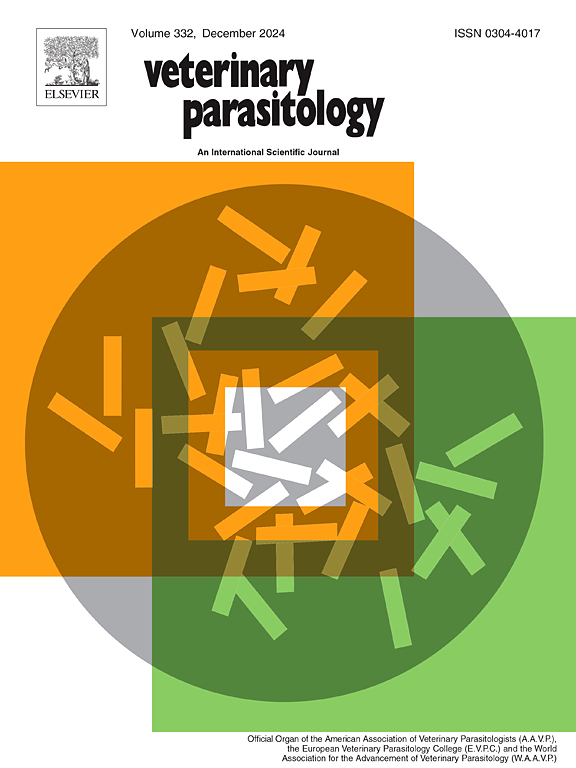Neospora caninum triggers the release of heterophil extracellular traps in chickens
IF 2
2区 农林科学
Q2 PARASITOLOGY
引用次数: 0
Abstract
Neospora caninum (N. caninum) has been recognized as a pathogen responsible for neosporosis in chicken. Heterophils, which are a crucial part of the chicken's innate immune response, employ heterophil extracellular traps (HETs) as a principal defense strategy against invading pathogens. However, whether N. caninum can trigger the release of HETs remains unclear. This study presents the first evidence that N. caninum can induce the release of HETs in chickens and delves into the mechanisms that regulate this phenomenon. The impact of N. caninum on heterophil activity was evaluated using the CCK-8 assay. N. caninum- induced HETs were characterized using scanning electron microscopy and immunofluorescence. The release of N. caninum-induced HETs was quantified using a PicoGreen-based fluorescence microplate assay. Our findings revealed that heterophil activity remained unaffected by N. caninum infection. N. caninum induced thicknesses, reminiscent of HET-like structures, which primarily consisted of a DNA skeleton, citrullinated histone (citH3), and elastin. Furthermore, an increase in reactive oxygen species (ROS) production was detected during the release of N. caninum-induced HETs, a process that was found to be dependent on ROS-mediated activation, NADPH oxidase activity, glycolysis, toll-like receptor 2/4 (TLR2/4) and MAPK signaling pathways. N. caninum induced-HETs release was shown to be ROS-dependent, involving the activation of NADPH oxidase, ERK1/2, glycolysis, p38 MAPK, and toll-like receptor signaling pathways. In conclusion, this study is the first to elucidate the release mechanism of N. caninum-induced HETs in chicken, offering significant insights into the mechanisms underlying immune innate system against N. caninum infection.
犬新孢子虫引发鸡体内嗜杂性细胞外陷阱的释放
犬新孢子虫(N. caninum)是引起鸡新孢子虫病的病原。嗜异性粒细胞是鸡先天免疫反应的重要组成部分,利用嗜异性粒细胞胞外陷阱(HETs)作为抵抗入侵病原体的主要防御策略。然而,犬奈瑟菌是否能触发HETs的释放尚不清楚。本研究首次证实了犬链球菌可诱导鸡体内释放HETs,并深入探讨了调节这一现象的机制。采用CCK-8法评价犬芽孢杆菌对嗜杂杆菌活性的影响。利用扫描电镜和免疫荧光技术对犬奈瑟菌诱导的HETs进行了表征。采用picogreen荧光微孔板法定量测定犬氮诱导的HETs释放。我们的研究结果表明,嗜异性粒细胞活性不受犬奈瑟菌感染的影响。犬链球菌诱导的厚度,让人联想到het样结构,主要由DNA骨架、瓜氨酸组蛋白(citH3)和弹性蛋白组成。此外,在N. caninus诱导的HETs释放过程中检测到活性氧(ROS)产生的增加,这一过程依赖于ROS介导的激活、NADPH氧化酶活性、糖酵解、toll样受体2/4 (TLR2/4)和MAPK信号通路。结果表明,犬链球菌诱导的hets释放是ros依赖性的,涉及NADPH氧化酶、ERK1/2、糖酵解、p38 MAPK和toll样受体信号通路的激活。综上所述,本研究首次阐明了犬链球菌诱导的HETs在鸡体内的释放机制,为免疫先天系统对抗犬链球菌感染的机制提供了重要的见解。
本文章由计算机程序翻译,如有差异,请以英文原文为准。
求助全文
约1分钟内获得全文
求助全文
来源期刊

Veterinary parasitology
农林科学-寄生虫学
CiteScore
5.30
自引率
7.70%
发文量
126
审稿时长
36 days
期刊介绍:
The journal Veterinary Parasitology has an open access mirror journal,Veterinary Parasitology: X, sharing the same aims and scope, editorial team, submission system and rigorous peer review.
This journal is concerned with those aspects of helminthology, protozoology and entomology which are of interest to animal health investigators, veterinary practitioners and others with a special interest in parasitology. Papers of the highest quality dealing with all aspects of disease prevention, pathology, treatment, epidemiology, and control of parasites in all domesticated animals, fall within the scope of the journal. Papers of geographically limited (local) interest which are not of interest to an international audience will not be accepted. Authors who submit papers based on local data will need to indicate why their paper is relevant to a broader readership.
Parasitological studies on laboratory animals fall within the scope of the journal only if they provide a reasonably close model of a disease of domestic animals. Additionally the journal will consider papers relating to wildlife species where they may act as disease reservoirs to domestic animals, or as a zoonotic reservoir. Case studies considered to be unique or of specific interest to the journal, will also be considered on occasions at the Editors'' discretion. Papers dealing exclusively with the taxonomy of parasites do not fall within the scope of the journal.
 求助内容:
求助内容: 应助结果提醒方式:
应助结果提醒方式:


